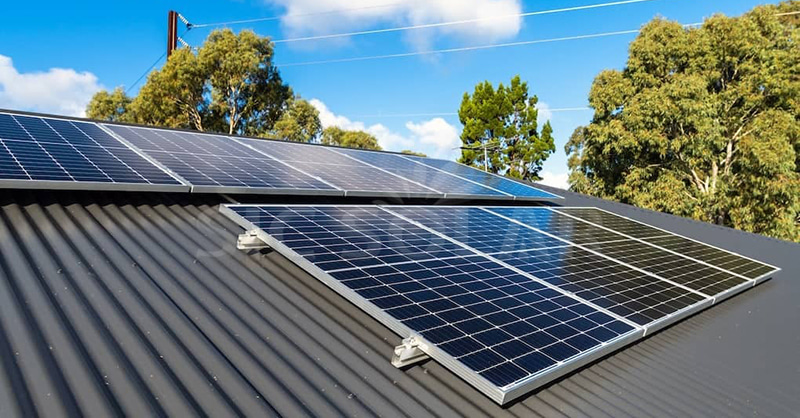When installing solar panels, one of the most important considerations is the position of your roof. The effectiveness of a solar panel system is greatly influenced by its orientation, tilt, and exposure to sunlight. Understanding the ideal roof position can maximize energy production and increase the return on your solar investment.

Why Roof Position Matters
The amount of energy solar panels generate depends largely on how much sunlight they receive. A poorly positioned solar system may produce significantly less energy, which could result in longer payback periods and reduced savings on energy bills.
Several factors impact the effectiveness of your solar panel system, including:
- Roof Orientation: The direction your roof faces affects the amount of sunlight the panels receive throughout the day.
- Roof Angle (Tilt): The tilt of your roof can impact how well your panels capture sunlight, especially during different seasons.
- Shading and Obstructions: Trees, buildings, or other structures can cast shadows, reducing the amount of sunlight hitting your panels.
Ideal Roof Orientation for Solar Panels
The best roof orientation for solar panels depends on where you are in the world. In general:
- In the Northern Hemisphere, solar panels should be installed facing south to capture the most sunlight throughout the day. A south-facing roof ensures the panels receive the maximum amount of direct sunlight, especially during peak hours, which are typically between 9 a.m. and 3 p.m.
- In the Southern Hemisphere, the ideal orientation is north-facing, as this position captures the most sunlight in that region.
If your roof doesn’t face the ideal direction, east- or west-facing panels can still generate a good amount of energy, but they will be less efficient compared to a south-facing installation in the northern hemisphere or a north-facing one in the southern hemisphere.
The Impact of Roof Angle
In addition to orientation, the angle or tilt of your roof is a crucial factor. Solar panels perform best when the angle matches the latitude of your location. This allows the panels to capture sunlight perpendicularly for most of the day, optimizing energy production.
For example:
- In areas close to the equator, a flat or nearly flat roof angle is ideal since the sun is almost directly overhead.
- In regions further from the equator, steeper roof angles are better to capture lower-angle sunlight, especially during the winter months.
If your roof’s pitch does not match the ideal angle, it’s not a major problem, as adjustable mounting systems, like those from SIC Solar, can help adjust the tilt of your panels to the optimal angle. This flexibility ensures your system performs efficiently even if your roof’s natural pitch isn’t perfect.
Dealing with Shading and Obstructions
Shading is another important factor to consider when determining the best roof position for your solar panels. Trees, neighboring buildings, chimneys, and other obstructions can cast shadows on your panels, significantly reducing their efficiency.
- Avoid shaded areas: Ensure that the panels are positioned where they receive the most direct sunlight, particularly during peak hours.
- Trim trees: If trees are causing shading, consider trimming them back to maximize sunlight exposure.
SIC Solar racking and mounting systems allow for flexible placement of panels, helping installers position them to avoid shaded areas and maximize sunlight exposure.
Flat Roofs and Solar Panel Installation
If you have a flat roof, you might think it’s less ideal for solar panels, but flat roofs actually offer a lot of flexibility. With the right mounting system, you can adjust the tilt and orientation of the panels to achieve the optimal angle and direction for your location.
In many cases, a flat roof allows you to position the solar panels at the perfect angle regardless of the natural pitch of the roof. SIC Solar offers adjustable mounting systems that can easily accommodate flat roof installations, ensuring maximum energy production.
Using Adjustable Mounting Systems for Optimal Positioning
Not all roofs are perfectly suited for solar panels. Some may face east or west, have steep pitches, or be obstructed by shading. This is where high-quality, adjustable mounting systems, like those from SIC Solar, come into play. These systems allow for:
- Customizable panel positioning: Even if your roof isn’t perfectly oriented or pitched, an adjustable mount can help position the panels at the optimal angle.
- Improved energy efficiency: By adjusting the tilt and angle, you can ensure your solar panels are capturing the maximum amount of sunlight possible, regardless of roof position.
- Durability and flexibility: SIC Solar’s mounting solutions are built from durable, weather-resistant materials, ensuring that your system remains secure and functional in any weather conditions.
Key Takeaways for Roof Positioning
- South-facing roofs (in the northern hemisphere) and north-facing roofs (in the southern hemisphere) are ideal for maximizing solar energy production.
- The tilt of your panels should match your location’s latitude to capture the most sunlight.
- Avoid shaded areas as much as possible to ensure optimal performance.
- Flat roofs offer excellent flexibility for panel positioning with the right adjustable mounting systems.
How SIC Solar Can Help
SIC Solar, a manufacturer of photovoltaic mounting systems, offers a wide range of solutions that help maximize the efficiency of solar panel installations. Whether you’re dealing with a flat roof, a steep pitch, or a roof that doesn’t face the ideal direction, SIC Solar mounting systems are designed to provide flexibility, durability, and ease of installation.
With adjustable racks and robust materials, SIC Solar mounting systems allow installers to position solar panels at the best possible angle and orientation, ensuring optimal sunlight exposure and energy production.
By choosing SIC Solar, you can be confident that your solar panels will be securely installed and positioned for maximum efficiency, regardless of your roof’s natural position or design.